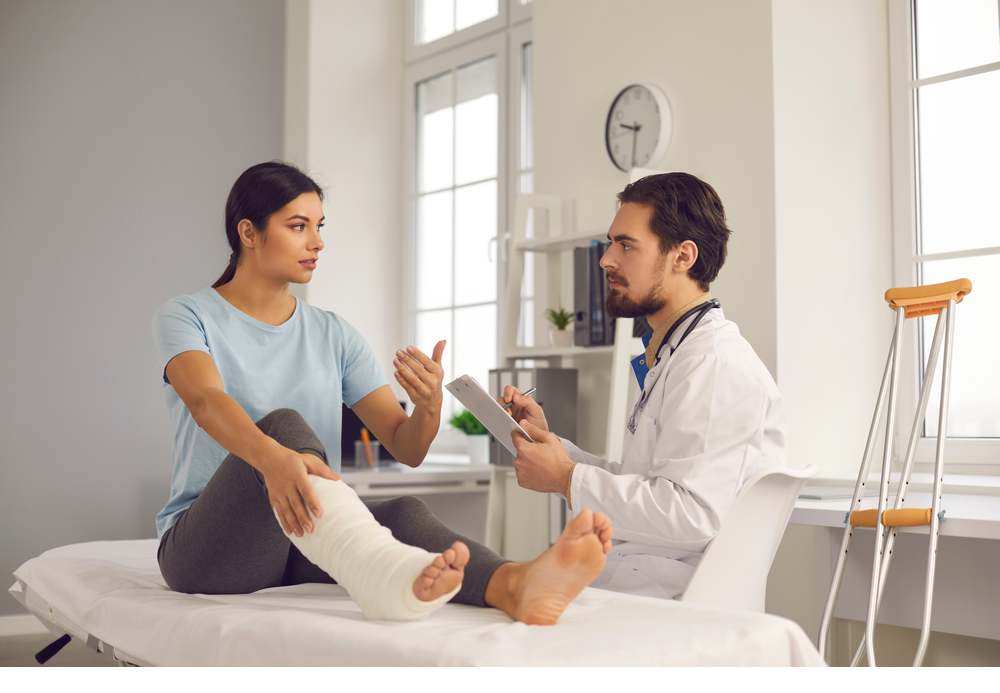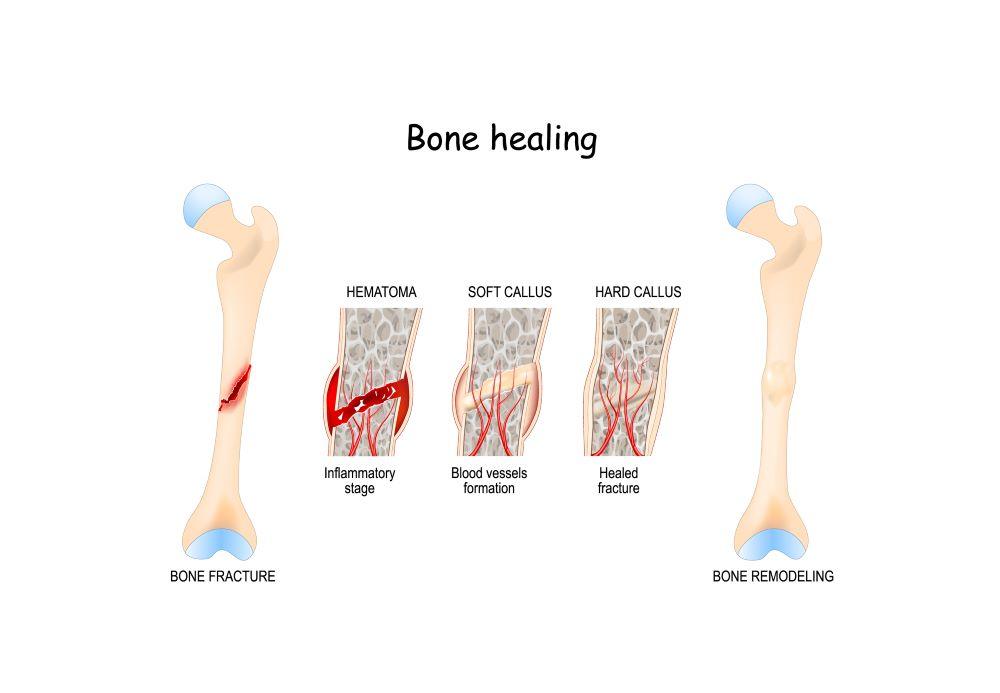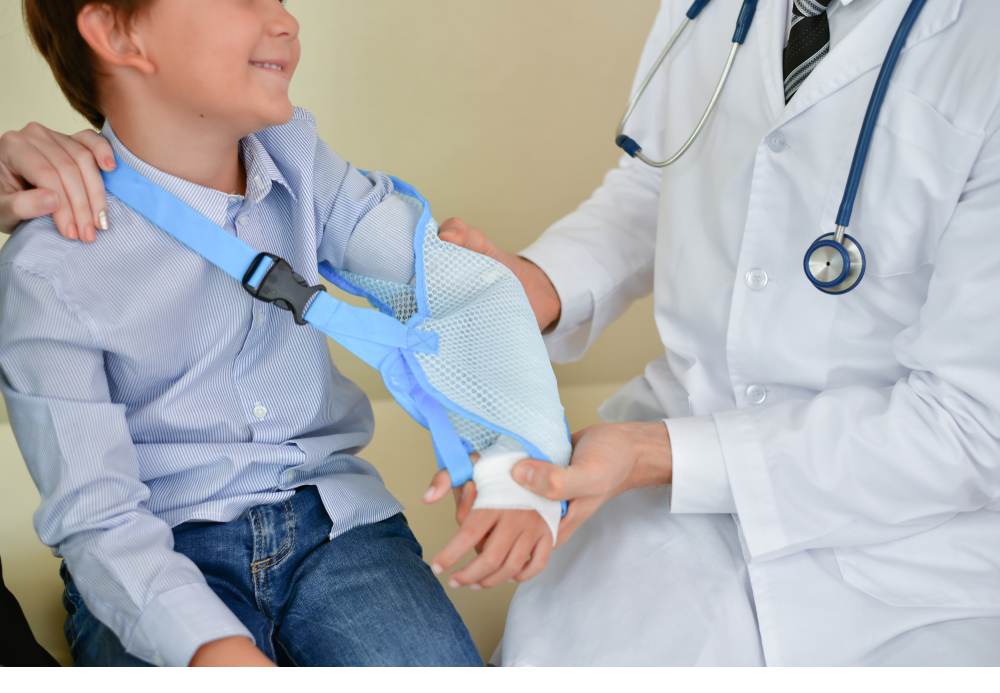If you’ve broken a bone, no matter if it is in your arm, leg, or spine – it can be frustrating and limit your daily activities. The good news is that broken bones heal relatively fast, usually within 6 to 8 weeks, but this is dependent on the severity and type of break. Your orthopedic doctor will give you an expected time frame for each step of the process and the best ways to support healing.
What Is a Fracture?
Fractures are the breaking of a bone in one or several places. The break can be partial or complete depending on the type. The following are types of fractures:
- Closed or Open- closed fractures do not break the skin whilst open fractures break through the skin.
- Complete- the break goes through the bone completely
- Displaced- a gap remains and the bone cannot join together without surgery
- Partial- the break only goes through part of the bone
- Stress- the break is a crack longways in the bone vs. across the bone.
What Causes a Fracture?
 When you suspect a fracture of any bone, you want to seek prompt medical treatment. AICA Atlanta offers diagnostics and treatment for accurate and efficient treatment of fractures. Fractures can be caused by many things such as car accidents, falls, sports injuries, or bones weakened by osteoporosis.
When you suspect a fracture of any bone, you want to seek prompt medical treatment. AICA Atlanta offers diagnostics and treatment for accurate and efficient treatment of fractures. Fractures can be caused by many things such as car accidents, falls, sports injuries, or bones weakened by osteoporosis.
Specifically:
- Trauma/Force- bones are strong, but too much force will cause them to break
- Osteoporosis- demineralization of osteoporosis weakens the bones leading to fracture
- Overuse- muscles can tire from repetitive motion and cause joint instability.
No matter the cause, AICA Orthopedic’s team of physicians, physical therapists, chiropractors, and support staff will collaborate to assess the injury, treat, and support you through the healing process.
What To Do if You Suspect a Fracture
If you suspect you or someone else has a fracture, please seek immediate medical attention. Every type of fracture does require medical treatment in order to heal correctly. Quick treatment will help to facilitate a speedy recovery.
Bleeding, open fractures, and unconsciousness all indicate a trip to the emergency department. Prior to moving the injured party, you should immobilize the injured area to prevent further damage and pain.
Even if these symptoms are not present, you should still take precautions and seek care at the emergency department or urgent care center.
How Does a Broken Bone Heal?
 Healing a broken bone is a multi-step process. It can be broken down into three phases. Immediately after a bone breaks, you will typically experience sharp pain and swelling. Sometimes called the Inflammatory Phase, this is the result of nerves reacting to the trauma and blood rushing to the site of the break. The blood surrounding the area forms a protective clot (1 to 5 days).
Healing a broken bone is a multi-step process. It can be broken down into three phases. Immediately after a bone breaks, you will typically experience sharp pain and swelling. Sometimes called the Inflammatory Phase, this is the result of nerves reacting to the trauma and blood rushing to the site of the break. The blood surrounding the area forms a protective clot (1 to 5 days).
Repair Phase
During the first week (5 to 11 days), post break and callus will begin to form. This begins as a spongy ‘sleeve’ of collagen, cartilaginous material, and osteoblasts that protects and stabilizes the fracture. As healing continues, this sleeve hardens into a bony callus (days 11 to 28), increases stability, and promotes healing.
Remodeling Phase
The bony callus is the foundation of the new bone. It is a place for blood vessels to anchor themselves and osteoblasts (cells that form new bone) to start building mature stronger bone approximately 18 days after a break. These cells create a bridge across the break and continue to form new bone, and the protective callus will harden (known as remodeling) over the ensuing weeks.
New bone will have completely repaired your fracture within a few months. The new bone tissue is thicker and stronger than the original bone. The strength in this new bone will actually prevent a break from happening in the same spot again.
4 Signs Your Bone Is Healing
Understanding the internal healing process can help you feel more comfortable about your injury, but knowing what to expect as healing progresses will ensure optimal recovery. These are guidelines, and you should consult your doctor before resuming normal activities of daily living. Each fracture is unique, and sometimes, your healing time will vary depending on the location and severity of the fracture.
Decrease in Pain and Discomfort
When you first break a bone, you will experience intense, focused pain often described as sharp or stabbing. That pain is usually caused by the instability of the break and trauma to surrounding nerves and tissues. As your bone heals and the callus and remodeling stabilize the break, the pain you experience will decrease.
The increased blood flow needed to remodel the break will also allow the nerves to heal quicker, facilitating less pain as your body resumes normal operations.
As your pain decreases, you might be tempted to put weight onto the affected limb. Be cautious with your movements, and don’t do too much too early. Relying on your doctor and physical therapist evaluations can help you make the best choice when resuming movement and functions of daily living.
Increase in Mobility
When you first break a bone, you will have very limited mobility. Initially, this is due to pain and tenderness. As the pain lessens and swelling decreases, you will be able to move the limb or join more freely. After your cast or brace is removed, mobility will increase, but your joint and limb might feel weaker due to the lack of movement in the area. This can be helped with physical therapy, moderated exercise, and time.
Decreased Swelling
The swelling surrounding a broken bone will begin to decrease as healing progresses. This is due to the increased stability of the break. The swelling is caused by the body sending blood rushing to the area as a way of helping to protect and stabilize a fracture.
Bruising Resolves
Bruising occurs when trauma to the skin damages blood vessels, and blood leaks out into the surrounding area. Initial bruises look dark, like purple or black. As healing progresses and swelling decreases, the body begins to absorb the leaked blood.
Bruises often go through several color changes ranging from purple, green, and even yellow. These are good signs and signify the tissue surrounding a break is healing.
Diagnosis and Treatment
Upon visiting AICA Orthopedics, you will have a physical exam by one of our physicians and consultation. This is followed by an X-ray done to diagnose the type, location, and severity of your fracture. If needed, AICA can perform more advanced imaging to thoroughly diagnose your fracture and plan an appropriate course of treatment.
Imaging
Common imaging services are X-ray, MRI, or CT scan. Your doctor will order the scan that will give the most accurate view of the fracture to help select the correct form of treatment.
While x-rays are the most common because they show images of the skeleton, sometimes an MRI (magnetic resonance image) or a CT (computed tomography) are needed to obtain more details of the fracture. All of these procedures can be performed in our AICA Atlanta offices.
Following imaging, your doctors at AICA Orthopedic will know exactly how to treat your fracture. Some fractures require the bone to be ‘set’ – the manipulation of the bones back into alignment prior to casting the limb to immobilize the break.
Surgical vs. Non-Surgical Treatment
Open Fracture Closed Fracture
An open fracture occurs when bone punctures the skin, while a closed fracture is still a break, but the skin remains intact. Closed fractures can typically be manipulated or set without surgery, while open fractures almost always require surgical intervention to set the fracture and repair the torn skin.
Traditional Cast
A traditional cast is a soft wrapping surrounded by a hard fiberglass shell. These are the most well-known types of casts and often come in fun colors! A traditional cast is applied after the bone is repositioned into the correct alignment. This immobilizes the break to allow the healing process to take place.
Functional Cast or Brace
These are traditionally made of molded plastic and are removable for cleaning. These are only used with fractures that are minor or more stable on their own.
Internal vs. External Fixators
Sometimes plates and screws are needed to stabilize a fracture. These can be completely internal or have rods and wires outside the skin that will be removed at a later time. These are placed during surgery. External fixators are removed as healing progresses. Internal fixators usually remain permanently.
Possible Complications
Occasionally you might deal with a complication in the healing process. If you notice anything unusual, please contact the staff at AICA Atlanta. Possible complications that could occur:
- Cast-related complications- These can range from pressure sores from an ill-fitted cast or swelling of the limb, yeast infections from lack of airflow and cleaning, or joint stiffness.
- Blood clots- This is the blocking of a blood vessel that disrupts the natural blood flow. Blood clots can become serious very quickly. Symptoms to watch for are localized swelling, skin being hot to touch, shortness of breath, and more.
- Compartment syndrome- This syndrome is caused when there is excessive swelling and blood collection in the muscles of the affected limb.
- Hemarthrosis- Similar to compartment syndrome, blood collects in the joints, causing swelling.
Supportive Treatment Options
Treatment for a fracture should occur as soon as possible after the injury. Early treatment helps promote strong and quality healing for future stability and strength in the bone.
Things that can impact your healing process:
- Age – Older patients often have a harder time healing a break due to natural demineralization of the bones (osteoporosis).
- Malnutrition – Poor nutrition slows the healing process due to a lack of important vitamins and minerals.
- Smoking – Smoking restricts blood vessels which are essential for healing.
- Obesity – Increased weight on joints and/or limbs can inhibit the healing process.
- Diabetes – Poor blood flow from diabetes reduces the speed with which nutrients travel to the injured area.
- Anemia – As previously stated, good blood flow promotes healing, and anemia’s reduced red blood cells will hinder the healing process.
Steps to Support the Healing Process
- Vitamin supplements (ie, D3, Calcium, Iron) as recommended by your doctor
- Physical therapy– improve range of motion and strength in surrounding muscles. Circulation is essential to healing.
- Pain management
- Cold laser therapy – reduce swelling and pain in joints and healing areas
- Chiropractic adjustments- to align the spine and/or surrounding joints
 AICA Atlanta provides all of the above services. Our physical therapists will help you strengthen the muscles surrounding your fracture to help prevent muscle wasting in the affected limb. Physical therapy can also improve your range of motion faster than without. Physical therapy can also assist in fine-tuning your balance and core strength to prevent future injuries and fractures.
AICA Atlanta provides all of the above services. Our physical therapists will help you strengthen the muscles surrounding your fracture to help prevent muscle wasting in the affected limb. Physical therapy can also improve your range of motion faster than without. Physical therapy can also assist in fine-tuning your balance and core strength to prevent future injuries and fractures.
While chiropractors don’t fix broken bones, they can perform adjustments to surrounding areas to promote improved nerve function and blood flow. Increased blood flow will help quicken healing as it is essential for the creation of osteoblasts and the callus that protects your remodeling break.
Both physical therapy and chiropractic care can help prevent complications like blood clots that can occur when your limb is dependent and immobile for extended periods of time.
Things You Can Do At Home
The following are things you can do at home to maintain optimal safety during the healing process as well as prevent future fractures.
- Clutter- remove clutter in the home, especially around walkways to prevent trips and falls
- Balance- work on improving this in physical therapy to help prevent future falls. You can also use a cane or walker if you aren’t stable enough on your own.
- Lights- make sure walkways are well lit
- Rugs- make sure rugs and mats are slip-free
- Weight bearing- remember to keep the affected limb elevated and don’t try to put pressure on the repaired fracture before your doctors’ recommendation.
Where To Go for Fracture Treatment
At AICA treating broken bones and care during the healing process is one of our specialties. AICA is staffed 24/7 and offers same-day appointments to take care of any fractures or associated injuries regardless of the cause. We can diagnose and treat initial injuries and treat you if you feel like your break isn’t healing well. To promote optimal healing, contact AICA to develop a plan and schedule an evaluation at one of our many Atlanta area locations.
